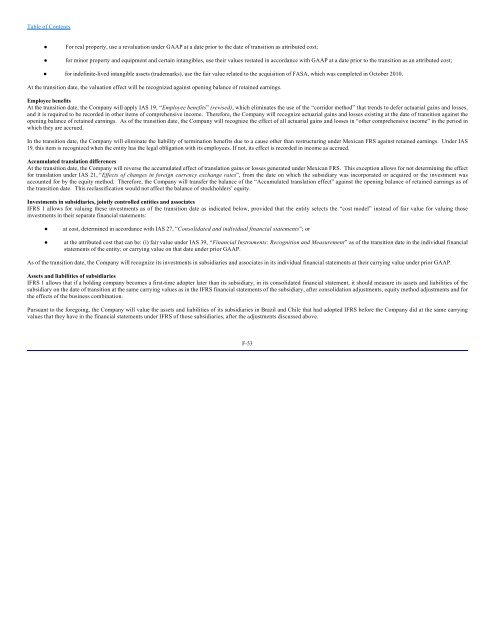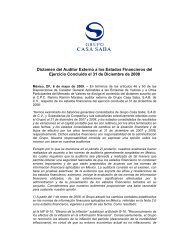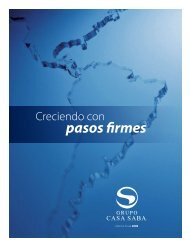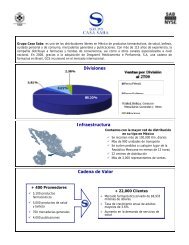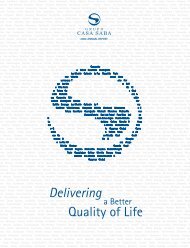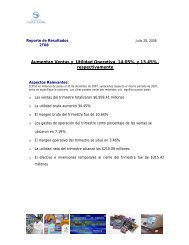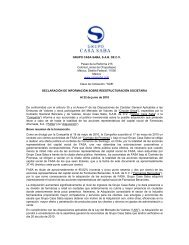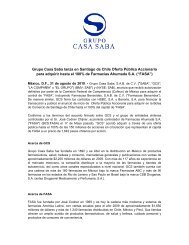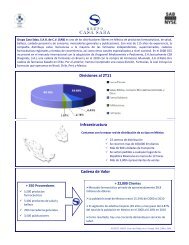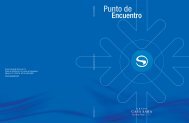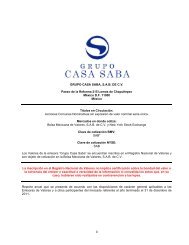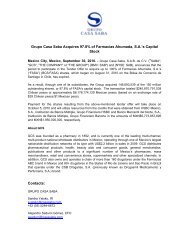FORM 20-F Grupo Casa Saba, S.A.B. de C.V.
FORM 20-F Grupo Casa Saba, S.A.B. de C.V.
FORM 20-F Grupo Casa Saba, S.A.B. de C.V.
Create successful ePaper yourself
Turn your PDF publications into a flip-book with our unique Google optimized e-Paper software.
Table of Contents<br />
●<br />
●<br />
For real property, use a revaluation un<strong>de</strong>r GAAP at a date prior to the date of transition as attributed cost;<br />
for minor property and equipment and certain intangibles, use their values restated in accordance with GAAP at a date prior to the transition as an attributed cost;<br />
● for in<strong>de</strong>finite-lived intangible assets (tra<strong>de</strong>marks), use the fair value related to the acquisition of FASA, which was completed in October <strong>20</strong>10.<br />
At the transition date, the valuation effect will be recognized against opening balance of retained earnings.<br />
Employee benefits<br />
At the transition date, the Company will apply IAS 19, “Employee benefits” (revised), which eliminates the use of the “corridor method” that trends to <strong>de</strong>fer actuarial gains and losses,<br />
and it is required to be recor<strong>de</strong>d in other items of comprehensive income. Therefore, the Company will recognize actuarial gains and losses existing at the date of transition against the<br />
opening balance of retained earnings. As of the transition date, the Company will recognize the effect of all actuarial gains and losses in “other comprehensive income” in the period in<br />
which they are accrued.<br />
In the transition date, the Company will eliminate the liability of termination benefits due to a cause other than restructuring un<strong>de</strong>r Mexican FRS against retained earnings. Un<strong>de</strong>r IAS<br />
19, this item is recognized when the entity has the legal obligation with its employees. If not, its effect is recor<strong>de</strong>d in income as accrued.<br />
Accumulated translation differences<br />
At the transition date, the Company will reverse the accumulated effect of translation gains or losses generated un<strong>de</strong>r Mexican FRS. This exception allows for not <strong>de</strong>termining the effect<br />
for translation un<strong>de</strong>r IAS 21, “Effects of changes in foreign currency exchange rates”, from the date on which the subsidiary was incorporated or acquired or the investment was<br />
accounted for by the equity method. Therefore, the Company will transfer the balance of the “Accumulated translation effect” against the opening balance of retained earnings as of<br />
the transition date. This reclassification would not affect the balance of stockhol<strong>de</strong>rs’ equity.<br />
Investments in subsidiaries, jointly controlled entities and associates<br />
IFRS 1 allows for valuing these investments as of the transition date as indicated below, provi<strong>de</strong>d that the entity selects the “cost mo<strong>de</strong>l” instead of fair value for valuing those<br />
investments in their separate financial statements:<br />
●<br />
●<br />
at cost, <strong>de</strong>termined in accordance with IAS 27, “Consolidated and individual financial statements”; or<br />
at the attributed cost that can be: (i) fair value un<strong>de</strong>r IAS 39, “Financial Instruments: Recognition and Measurement” as of the transition date in the individual financial<br />
statements of the entity; or carrying value on that date un<strong>de</strong>r prior GAAP.<br />
As of the transition date, the Company will recognize its investments in subsidiaries and associates in its individual financial statements at their carrying value un<strong>de</strong>r prior GAAP.<br />
Assets and liabilities of subsidiaries<br />
IFRS 1 allows that if a holding company becomes a first-time adopter later than its subsidiary, in its consolidated financial statement, it should measure its assets and liabilities of the<br />
subsidiary on the date of transition at the same carrying values as in the IFRS financial statements of the subsidiary, after consolidation adjustments, equity method adjustments and for<br />
the effects of the business combination.<br />
Pursuant to the foregoing, the Company will value the assets and liabilities of its subsidiaries in Brazil and Chile that had adopted IFRS before the Company did at the same carrying<br />
values that they have in the financial statements un<strong>de</strong>r IFRS of those subsidiaries, after the adjustments discussed above.<br />
F-53


